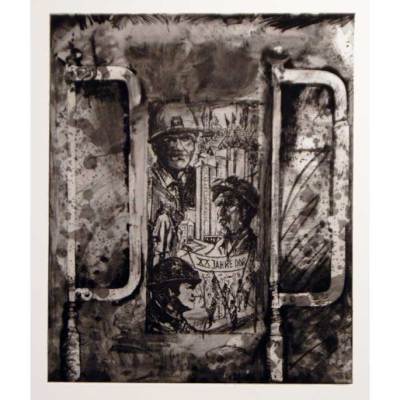An earnest girl in a Hackney pub once told me she was fascinated by motorway flyovers; ‘I just think they’re the most awesome things. Don’t you think?’ For the following half hour she described some of her favourites and the features which endeared them to her whilst I tried hard to remember any ever making such an impact on me.
Cooling Towers (1967–84), Bernd + Hilla Becher © courtesy the artist and Sprüth Magers Berlin London

Sprüth Magers’ London gallery is currently given over to two artists’ similarly esoteric passion for utilitarian architecture. For 50 years, until his death in 2007, Bernd and Hilla Becher’s fascination with industrial buildings led them to catalogue Cooling Towers, Water Towers, Gas Tanks and a multitude of the other structures created in the latter stages of the industrial age. They did so most famously through grids of photos, organised into typologies of buildings, whilst other standalone images celebrate the individual elements of these structures.
Their approach to this celebration was pragmatic and at first not clearly a celebration at all. Seen as a whole the grids of images look repetitive and generic. There is little extraneous space in the tight crops, and the buildings were all shot on overcast days to minimise potentially dramatic shadows. Each image is named with only the location and date of the photo. It is very much in contrast to Rodchenko and the constructivists’ earlier work with similar buildings, which venerated them through abstractions and dramatic viewpoints.
Blast Furnace, Boel, La Louvière (1985), Bernd + Hilla Becher © courtesy the artist and Sprüth Magers Berlin London

Shot straight-on using a large depth of field the Bechers’ structures are analytical and finely detailed. It is possible for instance to compare the finials on a gas tank in Beckton with the lack of any similar ornamentation, other than the ubiquitous rivets, on a gas tank in Bolton. Each building in a typological set can be identified for its individual features. In much the same way that one might read different faces in a portraiture exhibition, each building for Bernd took on ‘a look of it’s own’.
Further to the varying structural forms, there are often details giving hints to the buildings’ wider contexts. A swastika graffitied next to a hammer and sickle on the wall below a water tower in Mannheim gives a small indication of social tensions in the latter stages of the industrial age.
Other photographers, Chris Killip for example, have chosen to explore this more personable side of industrialisation. The Bechers are ambivalent to the politics though; these works are purely an appreciation of the sort of structures and engineering solutions that Bernd grew up close to in his childhood home of Siegen. Each typology represents the varying solutions engineers found to the structural challenges faced. They are responding to only practical concerns, with these challenges representing a break from the ideological concerns of the time.
Bernd described the demolition of his first subject (a mine near Siegen) as a ‘trigger’ for the works. ‘I was overcome with horror when I noticed that the world in which I was besotted was disappearing’. After meeting the more accomplished photographer Hilla he set out to document these buildings before they were all demolished.
Lime Kiln, Haanstätten (1992), Bernd + Hilla Becher © courtesy the artist and Sprüth Magers Berlin London

Few of the buildings in the images on show are still in use, adding to the sense of coolness already evoked by the analytical nature of the images. Weeds poke out from behind the walls of a lime kiln in Haanstätten and none of the cooling towers vent any steam. The Bechers’ passion for these forgotten structures has led to an improved appreciation of their cultural significance and it was the Bechers’ initiative which resulted in the listing of the Zollern coal mine near Dortmund as a protected landmark.
The Bechers’ images are exceptional examples of archival photography. The potentially forgotten buildings they photographed typified an age’s belief in form following function. And although they initially appear detached and repetitive, it is through the study of the typologies – which they dedicated their lives to and which Hilla still pursues – that Bernd and Hilla’s passion is borne out and shared.
‘Bernd & Hilla Becher’ is at Sprüth Magers, London, until 4 October.
Related Articles




